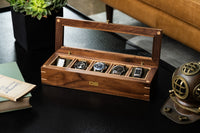Nothing quite says “Casual Friday” like an Aloha shirt.
Suburban dads, Brooklyn hipsters, starving (or very wealthy) artists, kids, and yes, the quirky staff of Analog:Shift — people of all stripes love these colorful, button-down tops and gleefully sport them in daily life. Though they come in and out of fashion, they’ve been a staple of the American wardrobe for nearly a century, reflecting a sense of positivity and a love of nature.
But where did this shirting style originate, and how did it come to possess the longevity it’s so impressively retained? Since we enthusiastically sport them so often around our offices, we figured we’d find out…

Blue Hawaii
The Aloha shirt indeed has its origins on — well — Hawaii, that most beloved of American states. (Which was only incorporated into the Union in 1959, believe it or not.) Between 1898 and 1959, when the island group was a U.S. territory, it occupied a special place in the American imagination. Regardless of whether or not one had physically visited, Hawaiian culture had permeated the zeitgeist, with Hawaiian music outselling other genres in the continental U.S. in 1916, just before the U.S. entered the First World War in 1917.

Member of the armed forces wearing an aloha shirt — circa 1950s
Due to its location in the midst of the Pacific between Asia and North America, Hawaii had long had a strong Japanese influence and population. At some point during the 1920s or 1930s, local Japanese adopted kimono fabric for use in shirting, giving rise to the first of what is often referred to as the “Hawaiian shirt,” or “Aloha shirt.” (More on the proper term use later.) Due to their Japanese origins, these early Hawaiian shirts featured distinctly Japanese patterns and scenes, with Mt. Fuji and cherry blossoms figuring into the imagery.
They were a feel-good (and decidedly feminine-inspired) product whose adoption by American tourists in Hawaii provided an ironic counterpoint to the hyper-masculine wave pervading 1930s U.S. culture, a time in which bodybuilding was gaining in popularity and the mafia was consistently in the headlines. Perhaps because it functioned as a sunny antidote to the positively un-sunny economic disposition of Depression-era America, the Aloha shirt became intensely popular.

Koichiro Miyamoto, known as Musa-Shiya the Shirtmaker, measures out a length of a beautiful lobster print fabric. ( via TheAlohaShirt.com )
Who the first shirtmaker to produce such a shirt was remains murky. According to what we can only term “sartorial lore,” the origins lie with one Kōichirō Miyamoto, proprietor of a dry goods store in Honolulu called “Musa-Shiya the Shirtmaker.” An alternative history, meanwhile, attributes the design to a Chinese merchant named Ellery Chun, whose shirts rose to prominence in the 1930s when they were sold at King-Smith Clothiers and Dry Goods in Waikiki.

An original "Musa-Shiya The Shirtmaker" label
By the mid-1930s, the word “aloha” had come into fashion, having been associated with anything and everything Hawaiian. A print advertisement for Musa-Shiya the Shirtmaker from the June 28, 1935 issue of The Honolulu Advertiser was supposedly the first to use the term “Aloha shirt,” though Ellery Chun may have used the term as early as 1933 in window signage. In 1936, Chun registered a trademark for the term “Aloha sportswear,” and trademarked “Aloha shirt” in 1937 — a name he retained for 20 years.
Regardless of with whom the idea for the Aloha shirt originated, they were all the rage by the eve of America’s entrance into the Second World War, representing an $11M annual business by 1940. In mainland America, men were buying them by the droves, representing as they did “symbol[s] of the comfortable, gay and picturesque,” according to one journalist. Japan’s attack on Pearl Harbor in December of 1941, however, did have an effect upon the business: Initially, it forced shirtmakers — like manufacturers in most American industries — to switch over to wartime production. Once the fighting stopped, production of Hawaiian shirts resumed, but this time, Japanese-influenced designs were supplanted by native Hawaiian motifs.

Elvis Presley in 1961's Blue Hawaii
As servicemen rotated through Hawaii and came home to the U.S. mainland, the Hawaiian shirt further penetrated American culture. It certainly helped that celebrities such as Montgomery Clift, Bing Crosby and Elvis were seen sporting them — 1961’s Blue Hawaii most certainly helped the shirt’s cause — and that “casual Fridays” or even “Aloha Fridays” became a fixture of the American workweek during this time. By the early 1980s, Tom Selleck was regularly sporting an Aloha shirt as Magnum P.I., further solidifying it as a staple item in even the most masculine man’s wardrobe.


How to wear an Aloha Shirt (with a yellow gold Yachtmaster!) nine ways by James Lamdin
These days, the Aloha shirt is still going strong. Brands like Kahala (founded in 1936) are reproducing their heritage designs — and selling them at luxury goods prices. But seeing as just about any producer of men’s clothing items makes them, one can easily find a Hawaiian shirt at any price point, which keeps this decidedly American menswear staple accessible to all.












